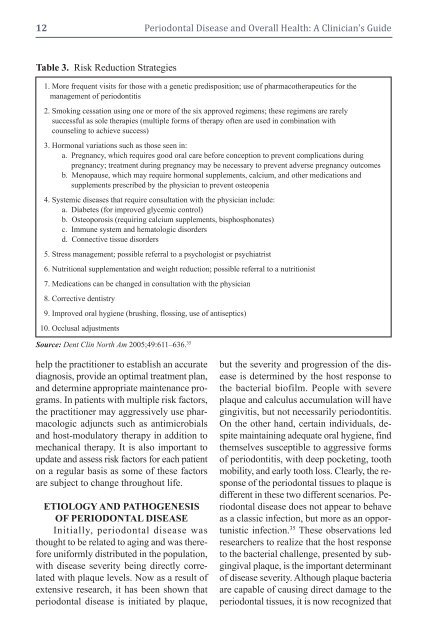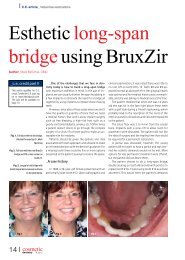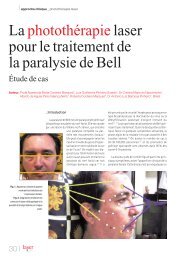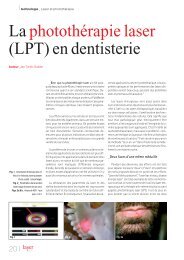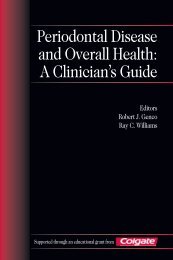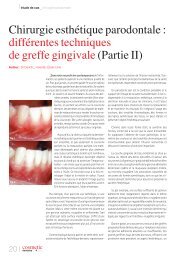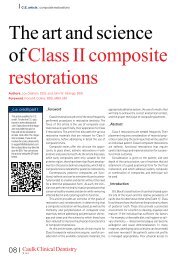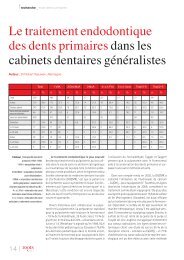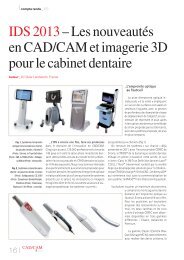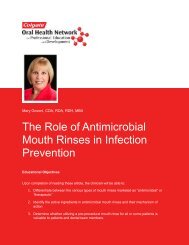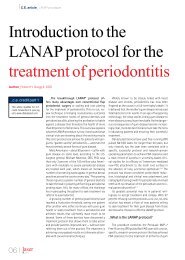Periodontal Disease and Overall Health: A Clinician's Guide
Periodontal Disease and Overall Health: A Clinician's Guide
Periodontal Disease and Overall Health: A Clinician's Guide
Create successful ePaper yourself
Turn your PDF publications into a flip-book with our unique Google optimized e-Paper software.
12 <strong>Periodontal</strong> <strong>Disease</strong> <strong>and</strong> <strong>Overall</strong> <strong>Health</strong>: A <strong>Clinician's</strong> <strong>Guide</strong>Table 3. Risk Reduction Strategies1. More frequent visits for those with a genetic predisposition; use of pharmacotherapeutics for the2.management of periodontitis2. Smoking cessation using one or more of the six approved regimens; these regimens are rarely2. successful as sole therapies (multiple forms of therapy often are used in combination with2. counseling to achieve success)3. Hormonal variations such as those seen in:a. Pregnancy, which requires good oral care before conception to prevent complications duringa. pregnancy; treatment during pregnancy may be necessary to prevent adverse pregnancy outcomesb. Menopause, which may require hormonal supplements, calcium, <strong>and</strong> other medications <strong>and</strong>a. supplements prescribed by the physician to prevent osteopenia4. Systemic diseases that require consultation with the physician include:a. Diabetes (for improved glycemic control)b. Osteoporosis (requiring calcium supplements, bisphosphonates)c. Immune system <strong>and</strong> hematologic disordersd. Connective tissue disorders5. Stress management; possible referral to a psychologist or psychiatrist6. Nutritional supplementation <strong>and</strong> weight reduction; possible referral to a nutritionist7. Medications can be changed in consultation with the physician8. Corrective dentistry9. Improved oral hygiene (brushing, flossing, use of antiseptics)10. Occlusal adjustmentsSource: Dent Clin North Am 2005;49:611–636. 35help the practitioner to establish an accuratediagnosis, provide an optimal treatment plan,<strong>and</strong> determine appropriate maintenance programs.In patients with multiple risk factors,the practitioner may aggressively use pharmacologicadjuncts such as antimicrobials<strong>and</strong> host-modulatory therapy in addition tomechanical therapy. It is also important toupdate <strong>and</strong> assess risk factors for each patienton a regular basis as some of these factorsare subject to change throughout life.ETIOLOGY AND PATHOGENESISOF PERIODONTAL DISEASEInitially, periodontal disease wasthought to be related to aging <strong>and</strong> was thereforeuniformly distributed in the population,with disease severity being directly correlatedwith plaque levels. Now as a result ofextensive research, it has been shown thatperiodontal disease is initiated by plaque,but the severity <strong>and</strong> progression of the diseaseis determined by the host response tothe bacterial biofilm. People with severeplaque <strong>and</strong> calculus accumulation will havegingivitis, but not necessarily periodontitis.On the other h<strong>and</strong>, certain individuals, despitemaintaining adequate oral hygiene, findthemselves susceptible to aggressive formsof periodontitis, with deep pocketing, toothmobility, <strong>and</strong> early tooth loss. Clearly, the responseof the periodontal tissues to plaque isdifferent in these two different scenarios. <strong>Periodontal</strong>disease does not appear to behaveas a classic infection, but more as an opportunisticinfection. 35 These observations ledresearchers to realize that the host responseto the bacterial challenge, presented by subgingivalplaque, is the important determinantof disease severity. Although plaque bacteriaare capable of causing direct damage to theperiodontal tissues, it is now recognized that


